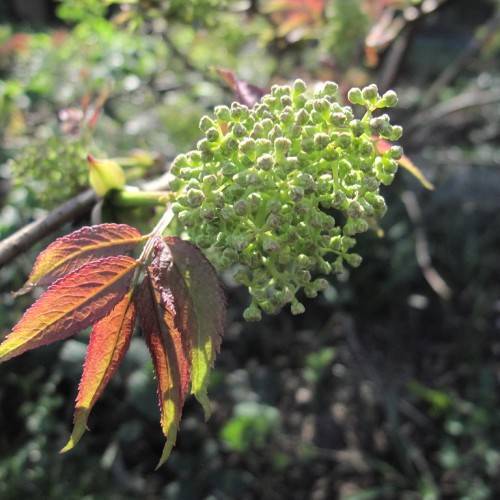
red elderberry
Sambucus racemosa 'Sutherland Gold'
Cycle:
Perennial
Watering:
Frequent
Hardiness Zone:
3 - 7
Flowers:
Flowers
Sun:
Full sun,part shade
Fruits:
Fruits Ready In Fall
Leaf:
Yes
Growth Rate:
Low
Maintenance:
Moderate
Drought Tolerant:
Yes
Care Level:
Medium
watering
Red elderberry (Sambucus racemosa 'Sutherland Gold') needs to be watered adequately in order to survive and thrive. During the growing season (spring to mid-autumn) water plants enough to keep the soil damp, but not soggy. This species likes fertile, consistently moist soil and a layer of organic mulch to help retain moisture. Water once or twice a week in summer and once every 10 to 14 days in the cooler months. Make sure there is good drainage, as standing water can lead to root rot. Additionally, reduce watering after the plants are dormant in the winter.
sunlight
Red elderberry (Sambucus racemosa 'Sutherland Gold') grows best in full or partial sunlight. It should get at least 5 to 6 hours of direct sunlight daily in the spring and summer months, and a minimum of 3 to 4 hours daily in the fall and winter months. Avoid planting it in an area that is always shaded, as it may not thrive. Additionally, it should be noted that this species of elderberry prefers some light dappled shade during the hot middle of the day in the summer.
pruning
Red elderberry (Sambucus racemosa 'Sutherland Gold') should be pruned once a year in the late winter or early spring. Prune the branches back to ensure shape and control growth, and to encourage bushier foliage and better flowering. Be sure to remove any dead, diseased, or damaged wood. Additionally, it's a good idea to prune any shoots that are crossing over or rubbing up against each other. Pruning should be done selectively and in moderation to ensure healthier growth. For the specific species of Red Elderberry, the best pruning practice is to selectively remove the older branches that are less vigorous. Doing so will provide room for the younger shoots to emerge and bear the clusters of sweet-smelling white flowers with yellow centers.
